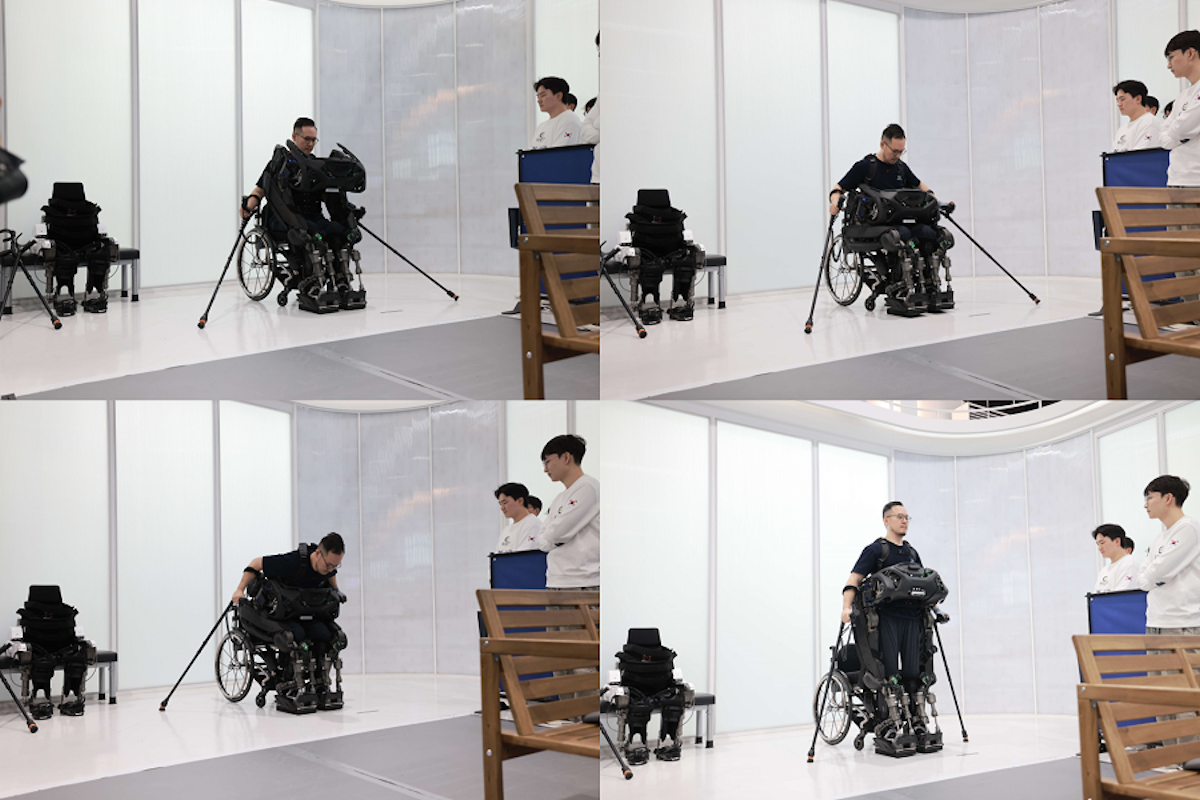Front-Loading Exoskeleton Helps Paralyzed Patients Walk

KAIST
Exoskeletons have assisted paraplegic patients in walking for years, but KAIST’s latest model offers a unique approach. The WalkON Suit F1 can move up to a patient in a wheelchair, secure itself around their legs and torso, and help them stand and walk.
Professor Kyoung-Chul Kong of KAIST’s Department of Mechanical Engineering has focused on exoskeletons for nearly a decade, unveiling the first WalkON Suit in 2016. By 2020, the team had boosted its walking speed to 3.2 km/h (1.98 mph) and entered the fourth-generation prototype in Switzerland’s Cybathlon.
A Global Showcase for Assistive Technology Innovation
Launched in 2016 by ETH Zurich, this “cyborg Olympics” aims to spur advancements in assistive technologies. The inaugural event, held near Zurich, brought together teams from 25 countries, with 66 “pilots” competing. Four years later, pilots using KAIST’s WalkON Suit 4.0 took first and third place in the Exoskeleton Race. This past weekend, the third Cybathlon saw Professor Kong’s team debut the latest WalkON Suit model.
Unlike other exoskeletons that require assistance to lift paralyzed patients from their wheelchairs before securing them to the devices, the WalkON Suit F1 can autonomously approach patients and “walk on its own like a humanoid robot.” It is equipped with a front-docking system that allows the paraplegic user to stay seated while the exoskeleton positions itself around their body and legs.
Enhanced Stability and Control Features for Optimal User Support
To maintain stability and prevent tipping during the transition to a standing position, the suit incorporates a system that actively manages its center of gravity. Its overall balance has been optimized, enabling users to use both hands while upright and take short steps without needing a support cane. The motors and control algorithms have been significantly enhanced compared to earlier models, and the setup also includes vision recognition technology for detecting obstacles.

KAIST
Seunghwan Kim Pilots WalkON Suit in 2024 Cybathlon Exoskeleton Competition
Seunghwan Kim, a staff researcher at the engineering lab, served as the pilot for the 2024 Cybathlon’s exoskeleton competition. While some teams traveled to Switzerland to participate, Professor Kong’s team opted to live stream their attempt from the special facilities of Angel Robotics, the company he founded in 2017 to commercialize wearable robots.
Teams faced various challenges within a limited timeframe, including tasks such as sidestepping between narrow chairs, moving boxes, walking unassisted without crutches, passing through a narrow door and closing it, and preparing food in the kitchen.

KAIST
Kim and the WalkON Suit F1 completed all tasks in 6 minutes and 41 seconds, earning first place. A Swiss team secured second place, while Thai engineers took third, but neither managed to finish all their tasks within the 10-minute limit.
A KAIST press release highlighting the victory stated, “The various expertise and core technologies developed in preparation for this competition will contribute to the further advancement and dissemination of wearable robots, inspiring imagination about the future of these devices and their potential impact on our daily lives.”
Read the original article on: New Atlas
Read more: Check it Out: Brave Robodog Takes a Stroll Underwater










